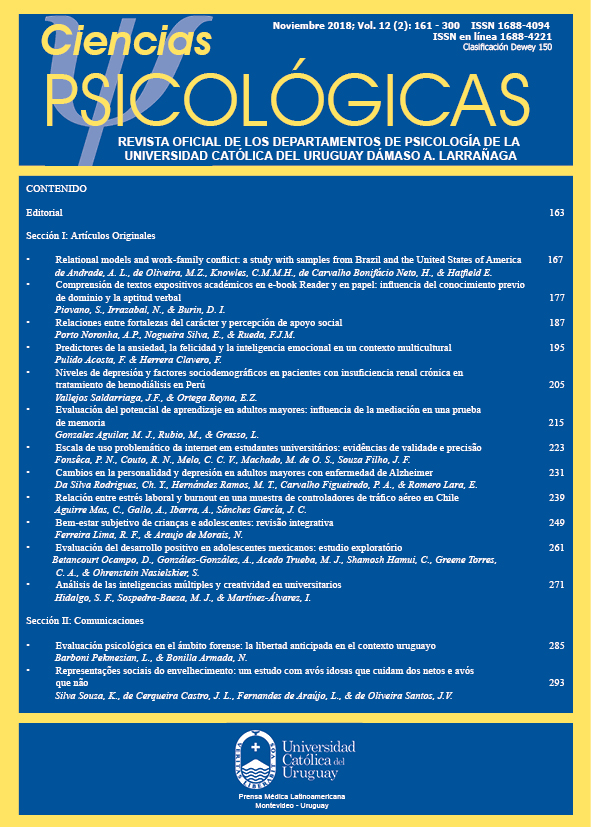Evaluación del desarrollo positivo en adolescentes mexicanos: estudio exploratorio
DOI:
https://doi.org/10.22235/cp.v12i2.1690Palavras-chave:
desarrollo positivo, adolescentes, evaluación psicológica, medición, escalaResumo
El objetivo del presente estudio fue diseñar y valorar psicométricamente un instrumento que evalúa el desarrollo positivo de adolescentes mexicanos. Para lo cual se seleccionó una muestra no probabilística de 400 adolescentes, estudiantes de nivel secundario, 57% fueron hombres y 43% mujeres, con un promedio de edad de 13.5 años. Con base en la revisión de la literatura se diseñó un instrumento basado en la propuesta de Lerner (2004), de 59 reactivos que se agrupan en cinco escalas Likert que evalúan las cinco características del desarrollo positivo: Competencia (13 reactivos, α= .809), Cuidado (6 reactivos, α= .672), Confianza (11 reactivos, α= .837), Conexión (17 reactivos, α= .920) y Carácter (12 reactivos, α= .854). Los resultados mostraron que el instrumento cuenta con propiedades psicométricas adecuadas para este estudio. La discusión analiza la utilidad del instrumento en población adolescente mexicana para la valoración del desarrollo positivo y como instrumento para evaluar la efectividad de programas de promoción del desarrollo saludable en adolescentes.
Downloads
Referências
Armsden, G. C., & Greenberg, M. T. (1987). The inventory of parent and peer attachment: Individual differences and their relationship to psychological well-being in adolescence. Journal of Youth and Adolescence, 16(5), 427-454. doi: https://doi.org/10.1007/BF02202939
Benson, P. L., Leffert, N., Scales, P. C., & Blyth, D. A. (2012). Beyond the “village” rhetoric: Creating healthy communities for children and adolescents. Applied Developmental Science, 16(1), 3-23. doi: https://doi.org/10.1080/10888691.2012.642771
Bowers, E.P., Li, Y., Kiely, M.K., Brittain, A., Lerner, J.V., & Lerner, R.M. (2010). The five Cs model of positive youth development: A longitudinal analysis of confirmatory factor structure and measurement invariance. Institute for Applied Research in Youth Development, Tufts University.
Eisenberg, N., Fabes, R. A., & Murphy, B. C. (1996). Parents’ reactions to children’s negative emotions: Relations to children’s social competence and comforting behavior. Child Development, 67(5), 2227-2247. doi: 10.1111/j.1467-8624.1996.tb01854.x
Geldhof, G.J., Bowers, E.P., Mueller, M. K., Napolitanto, C. M., Schmid, C. K., Walsh, K. J., Lerner, J. V., & Lerner, R. (2015). The Five Cs Model of Positive Youth Development. En E. P. Bowers, G. J. Geldhof, S. K. Johnson, L. J. Hilliard, R. M. Hershberg, J. V. Lerner, & R. M. Lerner (Eds.) Promotion Positive Youth Development. Lessons from the 4-h Study (pp. 161-186). USA: Springer.
Harter, S. (1983). Supplementary description of the Self-Perception Profile for Children: Revision of the Perceived Competence Scale for Children. Unpublished manuscript, University of Denver.
Heck, K. E., & Subramaniam, A. (2009). Youth Development Frameworks. [Monograph]. Davis, CA. Recuperado de: http://4h.ucanr.edu/files/1224.pdf
Jelicic, H., Bobek, D. L., Phelps, E., Lerner, R. M., & Lerner, J. V. (2007). Using positive youth development to predict contribution and risk behaviors in early adolescence: Findings from the first two waves of the 4-H Study of Positive Youth Development. International Journal of Behavioral Development, 31(3), 263-273. https://doi.org/10.1177/0165025407076439
Lerner, R. M. (2002). Concepts and theories of human development. Mahwah, NJ: Lawrence Erlbaum.
Lerner, R. M. (2004). Liberty: Thriving and civic engagement among America’s youth. Thousand Oaks, CA: Sage.
Lerner, R.M., Lerner, J.V., Almerigi, J.B., Theokas, C., Phelps, E., Gestsdottir, S… von Eye, A. (2005). Positive youth development, participation in community youth development programs, and community contributions of fifth-grade adolescents: Findings from the first wave of the 4-H study of positive youth development. Journal of Early Adolescence, 25, 17-71. doi: https://doi.org/10.1177/0272431604272461
Lopez, A., Yoder, J. R., Brisson, D., Lechuga-Pena, S., & Jenson, J. M. (2015). Development and validation of a positive youth development measure: The Bridge-Positive Youth Development. Research on Social Work Practice, 25(6), 726-736. doi: https://doi.org/10.1177/1049731514534899
Shek, D. T., & Ma, C. M. (2010). Dimensionality of the Chinese positive youth development scale: confirmatory factor analyses. Social Indicators Research, 98(1), 41-59. doi: https://doi.org/10.1007/s11205-009-9515-9
Theokas, C., Almerigi, J. B., Lerner, R. M., Dowling, E. M., Benson, P. L., Scales, P. C., & von Eye, A. (2005). Conceptualizing and modeling individual and ecological asset components of thriving in early adolescence. The Journal of Early Adolescence, 25(1), 113-143. doi: https://doi.org/10.1177/0272431604272460
















